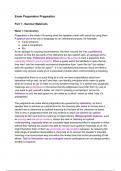Summary
Summary Pragmatics LCX056B05 English RUG Communication Information Studies
- Course
- Institution
Summary of the pragmatics course in communication information studies at RUG. From the year . Course code LCX056B05. My grade was 8.5.
[Show more]



